
The Problem: How it All Started
The hobby of board gaming is currently experiencing a renascence. check out BoardGameGeek here BoardGameGeek, the biggest board games database, has more than 70 000 games. Out of those, hundreds are worth playing. I got into this hobby four years ago and I then hit a wall. When I went to play games together with my friends we would spend hours choosing what to play. I felt I was missing out on good games and time I could spend playing.
I first had the idea of Tabletop Match when I saw an enormous decision tree meme that was meant to help you 'choose the perfect board game'. "This can surely be automatised" I told myself. So when I had to develop a mobile web app with strategical content for my Bachelor thesis I figured: "This is is!".

Understanding the Users
Inspired by Cooper’s book, About Face, one of the best written design books About Face, I wanted to apply Goal Oriented Design practices. So, I went to find out who my users are and what they need. It was the first time I conducted exploratory interviews, so my questions were pretty shaky:
- survey-like: How often do you play board games?,
- yes/no questions: Do you have any favourite game?,
- leading questions: Would you find useful answering a questionnaire before playing, which would give you as an answer a set of possible games you could play?
- or even unclear subjective questions: Would you consider yourself an expert or a casual player?
- but also very useful questions: What do you do when you want to try a new game?
To find interviewees, I went to a Disambiguation: 'Tabletop game' is a general term that refers to board games, card games, dice games, miniatures wargames, tile-based games and other games that are normally played on a table or a flat surface tabletop club and a hobby store in Herning, Denmark. In total I interviewed 15 men and one woman. Most of them were members of tabletop gaming clubs.
After a few interviews I quickly figured out some mistakes in my questioning, and I reformulated. But I did not fully understand how to devise good interview questions yet. Nonetheless, the data was interesting and patterns and personas evolved from it.
Fig 1. I first identified significant behavioural patterns, then I mapped the interviewees accordingly. In the end I indentified three groups which became the basis for personas

From this, I noticed several correlations between behaviours:
- Players who don’t belong to a club tend to know fewer games than players who do.
- Players who know a lot of games prefer to actively search for them. They are expert gamers and tabletop games are generally their main hobby.
- Players who belong to clubs tend to rely more on recommendations from others when trying new games
This helped distinguish three personas. A fourth persona was developed with the help of a Read more about Dan Shapiro and his board gamers venture here. New York Times article about how board games are very popular among parents and children who want alternative entertainment to computers.
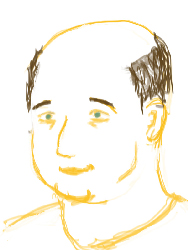
Quentin Smith
The Expert
Quentin’s main hobby has been tabletop gaming for the past 22 years. He knows a lot about tabletops and has a personal collection of hundreds of games. Quentin has founded several clubs and organized communities around games for 10 years now. He also owns the coolest hobby shop in the city. All the tabletop gamers in the city know and respect Quentin.
He is the guy Peter goes to when he wants to learn about a new game: Quentin knows the rules and has played over 250 games, and counting. He always knows the next hot game and he can recommend anyone something of their own liking. He knows all about game categorization, mechanics, and themes.
Quentin is a negative persona - he will not find the app useful, because he already knows a lot about games and knows how to find out more. But he is a key persona into the propagation of the app - the community trusts him.

Amandra Gray
The Casual Player
Amanda rediscovered board games two years ago, when her collage flat mates introduced her to Carcassonne. Before that, she used to play Monopoly, Scrabble with her family when she was a kid.
Amanda and her friends do many things together: go to concerts, festivals, cinema, and now she wants to introduce one more ‘tradition’: board gaming. She knows they’d love to spend some time together playing and trying all those new interesting board games that appeared recently. Unfortunately, she doesn’t know that much about tabletops and neither do her friends. She wished she could have time to do some thorough research on what’s out there, but there are so many new games, it’s almost scary.
Amanda is a primary persona. She is an outsider to the world of board games, and doesn’t belong to a club, so she would benefit the most from having an app to introduce her to new games. The recommendations can be based on time and player constraints and on games she previously enjoyed.

Peter Jensen
The Club Member
Peter has joined “Next Change”, a game club initiated by Quentin 5 years ago. He knows his way with games as he has played around 50 of them. But his favourite is still the one that introduced him to the gaming world: Dungeons & Dragons. Peter also goes to international D&D competitions.
One of the things he enjoys most about being part of “Next Change” is that he has the chance to try new games as he has so many at his disposal. Most of the times, Quentin and the other club members recommend him games and explain him the rules.
Peter is a secondary persona - he can still be satisfied with the primary persona’s interface, but he has specific additional needs such as advanced search terms for game mechanics and themes.
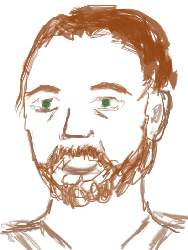
Gerry Goodman
The Family Gamer
Gerry has two kids: Melissa has 8 and Robin has 4. He loves to play with them and spend time with his family. Gerry has always been the fun father: looking for new ways to entertain his kids while joining in the fun.
When he was younger, Gerry used to play a lot of tabletops with his friends, and now he remembers how fun it was. His kids spend most of their free time on computers, tablets, phones. Of course, they go out a lot as well, but he wished he could provide them some in-doors entertainment that doesn’t include a screen.
Gerry is a secondary persona - he can still be satisfied with the primary persona’s interface, but he requires the to specify the age of players.
Shaping Up the Product
Our assumption was that gamers have a hard time finding a game they want to play. Yet, many tackled this by having experienced friends decide for them. When buying a game, the shop assistant is helping them chose. Also, enthusiasts who don’t belong to a club don’t have a wide choice of games, thus, it is easy to decide. Still, interviewees mentioned times when they took up to 90 minutes to decide which game to play.
From these interviews and consulting with Nicolai, we formulated the requirements for the app:
- Accessible both at home and in a hobby store or club
- The user can specify relevant features
- Work with as little input as possible
- End the filtering at any time
- Provide clear choices
- Overviews of each game
Thus, when using Tabletop Match, Amanda can answer a series of questions to specify which attributes she would like to experience in a game. When she has answered enough questions, she can end the search and get the results.

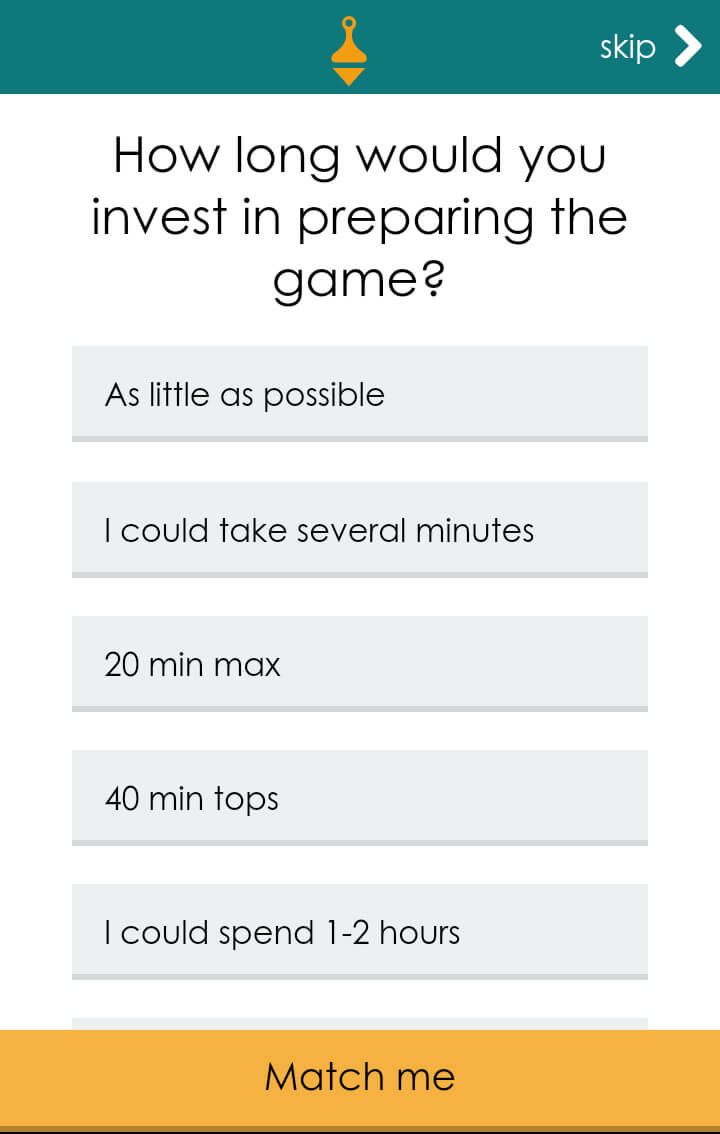

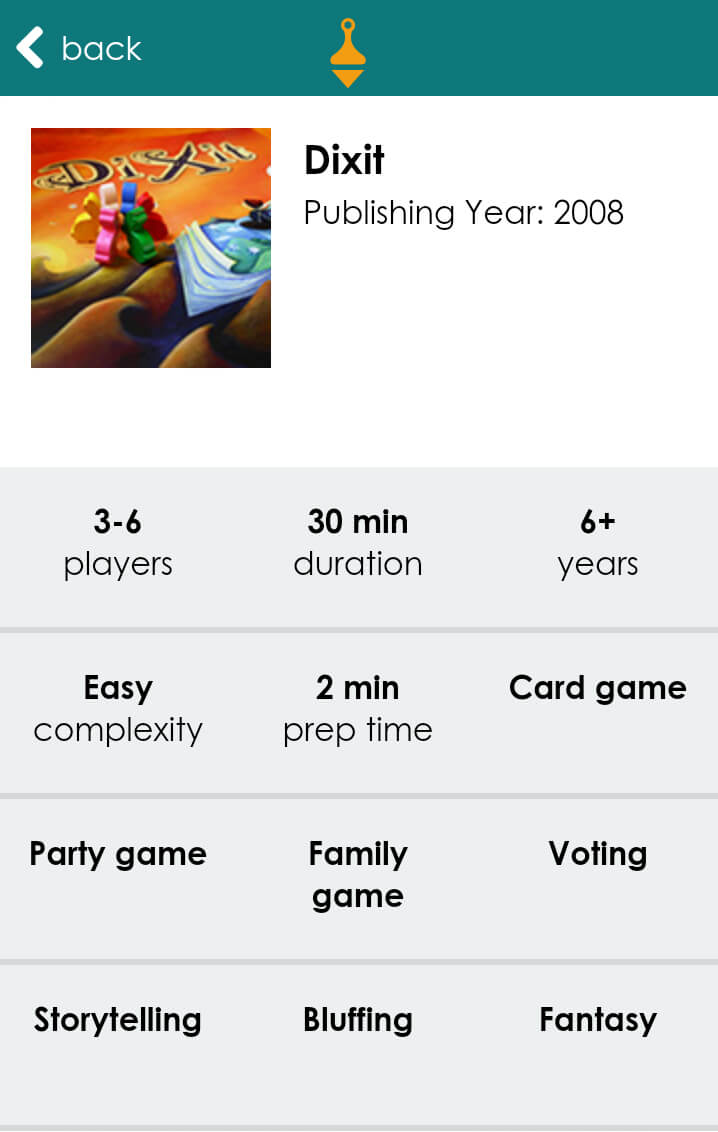
Evaluating the app
After developing an This version had 23 questions in a tree structure that would narrow down the game suggestions. alpha version of the app with PhoneGap technology, I went again to the hobby store to test it with actual users. The usability test was task-based and had 8 participants.
The most predominant issue was the little number of games. So, more often than not, the game search ended in a ‘sorry we couldn’t find your match’ screen. Users also felt that there were too many questions to answer and some interface elements were not evident enough.


the users did not notice they could skip questions, so they felt forced to answer everything
some users did not see the ‘Match me’ button.
Arising Challenges
The biggest struggle with this project was gathering a large database of games. Initially, we tried to open source the gathering of the games. So I designed a collection webpage and Andrei Neamtu from Geek Network implemented it. Yet, it is a tedious task to add a game, with enough details such as type, category, mechanics and theme.
We also considered gamifying the experience to motivate users to add new games, but it was only designed, not implemented:
The design of a profile page, with a leaderboard & badges

Another great challenge was devising a good algorithm to find the right game by asking as few questions as possible. The best solution would have been a machine learning algorithm that would find correlations between different gamers' preferences. But no one in the team knew how to implement such a solution.

Starting up anew
One year after the first iteration, I took up the challenge of Tabletop Match again. This time as part of my Master’s degree, together with a team of three, we had to build a viable tech business & product. My colleague, Andres Sierra, had always wanted to build a start-up around board games, as he’s an avid player and an entrepreneur. So we teamed up with Francesco Vitale, the amazing designer, and Wilfried Bock, the team's hacker, to bring Tabletop Match to the next level.
Arising Questions
- Does the initial concept of Tabletop Match really answer the needs of gamers?
- Are gamers our target market, or maybe someone else (game makers, game shops, game publishers)?
- How can we deliver value to users and sustain a start-up?
- Is this market big enough to build a business upon?
- How can we make profit?
- How can we grow?
A Business Approach
This time we used a business oriented process: Read more about the Lean Start-up Method the lean start-up methodology . We started by formulating and testing our assumptions using the Read more about how the Business Model Canvas is used to build great companies Business Model Canvas .
Along the process we changed the BMC 7 times until we reached a viable business model
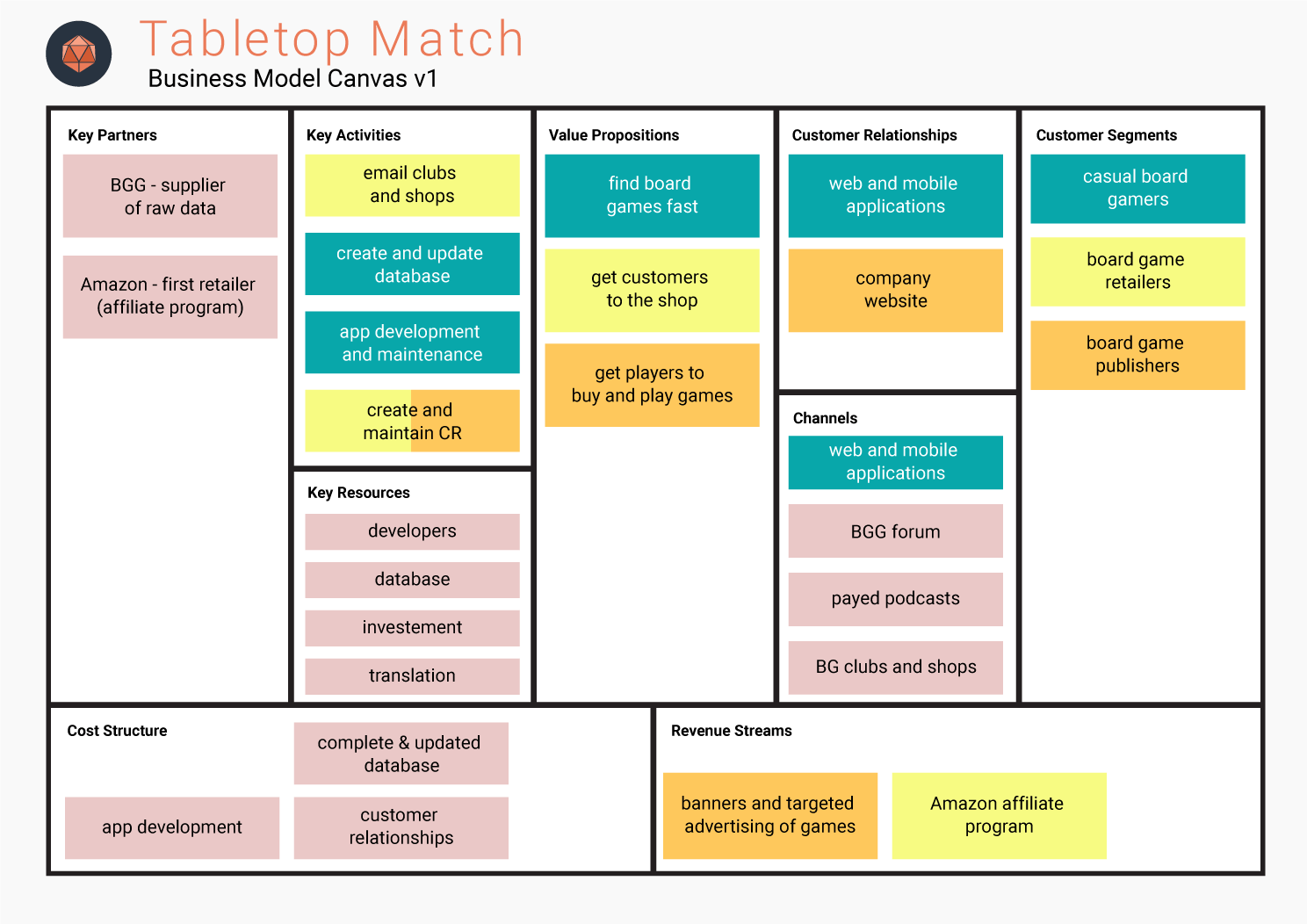
We then devised tests to validate each of our assumptions. For that we interviewed 9 board gamers and 3 owners of hobby stores.
Our assumption was that hobby stores would like to pay Tabletop Match to feature them as places where users can buy the games they want. But the stores we interviewed did not seem to need or want to pay for online advertisements.
But what we found is that with all the new games on the market, it was nearly impossible for hobby store employees to keep up. Yet customers heavily relied on them for advice. Thus shop assistants liked the idea of having a filtering app in their store to help them browse, understand and recommend games.
Customer Archetypes Diagram: Based on interviews, we divided our customers on two behavioral axes. This division is somehow similar to the personas developed earlier.
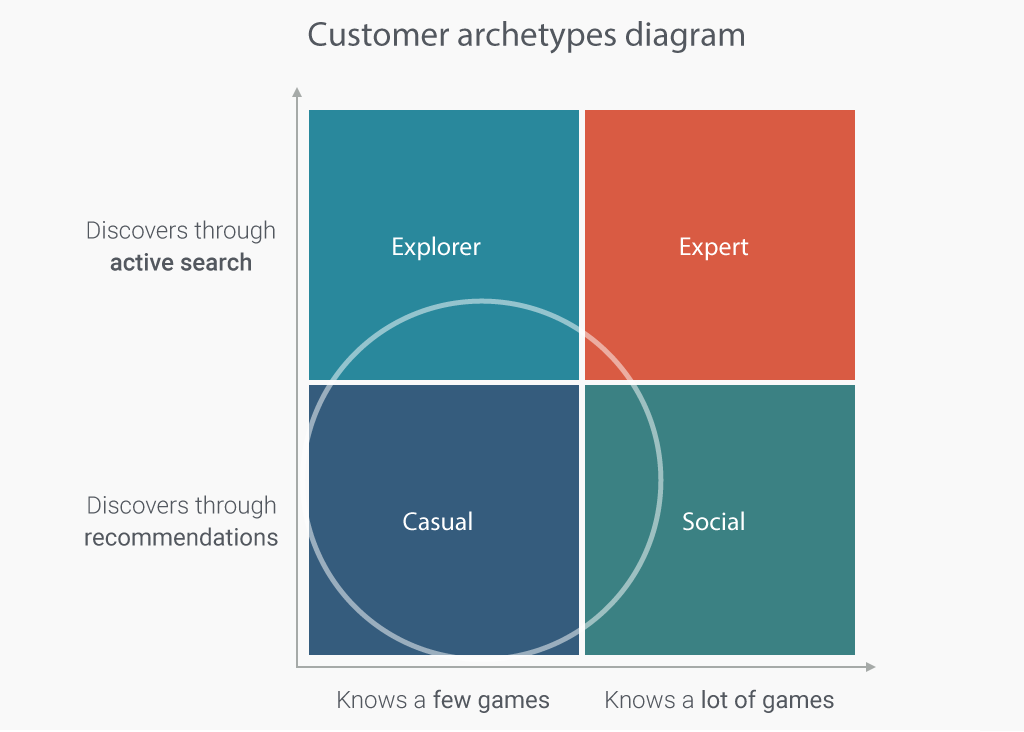
We decided to focus on casual gamers as our main user group and on board game stores as our customers. Tabletop Match pivoted to be a game inventory management system for hobby stores.

On top of that, the system has a customer-facing app on a tablet installed in the store. On this app, hobby store customers can filter through games and find the right match for them.
Customer Workflow inside a hobby store

A New Web App
We built a new web app to showcase our customer-facing interface concept. This time, Tabletop Match was built to be used on a tablet or desktop primarily.
Click here to play with the app
The problem with the initial matching method, multiple choice questions, was that the user had according to Miller's law, one can pay attention to seven ± two items at once too many choices (7 to 11).
To solve that, and inspired by reviewing one choice at a time helps users focus, and is a popular design pattern Tinder , in the new system one can answer a series of yes/no questions together with some hard filters to get a match. But this soon turned out to be a terrible design decision: a user would have to go through too many yes/no questions to get a relevant recommendation. In hindsight, a better solution would be to use multiple choice questions, like in the first iteration, but limit the choices to according to a more recent study, the number of items one can actively hold in working memory is actually four four .
We eventually figured how to solve one of our biggest challenges: building a proper database. By using each store's own database, we would not have crowd-source it or build it from scratch. Once we have access to several databases, we can cross-check them and complete the missing details.
Check out our company's promotional video
Killing our Darlings
The end of the university year arrived, and as a team we had to part before the project was complete. We left a lot of loose ends:
- designing a new multiple choice system
- releasing a beta to the public
- building the inventory management system
- building ways to migrate databases
- finding more customers (hobby stores)
As a team, we could not take Tabletop Match further, as each of us would move to another place. Moreover, we did not have the necessary technical skills to build database migrating system. Thus, Tabletop Match became again a personal project, for us to take further in our free time.
Lessons Learned
Tabletop Match is the project that I have grown with and has taught me the most about design and entrepreneurship. It was my sandbox, where I experimented and put into practice design theories and methods I learned from books and in university.
Through Tabletop Match I discovered my passion for understanding the users and their needs, for learning their stories and translating that into actionable design solutions.
Even if it was never released or launched as a start-up, the team has worked for Tabletop Match in the true spirit of a lean start-up. We built hypothesis, invalidated them, pivoted and took it dead serious until the very end.
In the end, I also learnt the hard lesson of loose ends and killing your darlings. It was difficult to let go of the project that I have grown with.
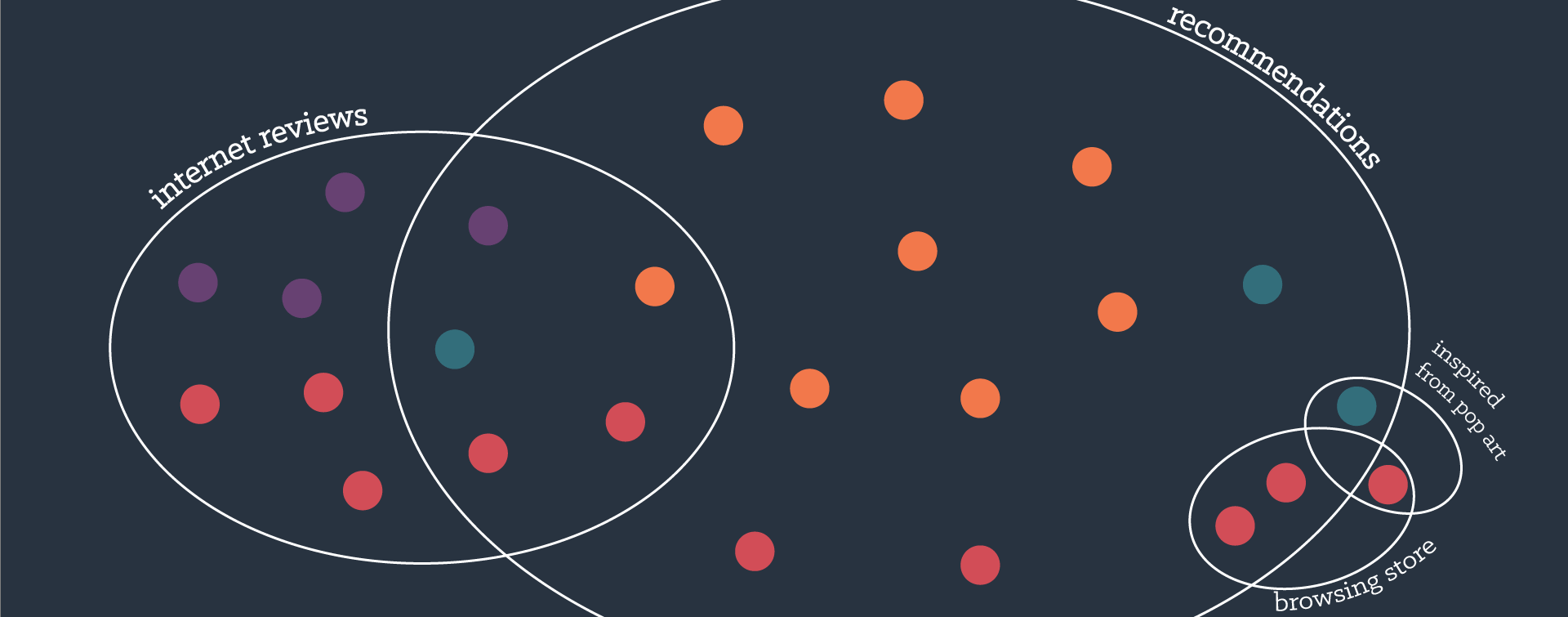
Curiosity Killed the Cat
During the past two project iterations we conducted 25 interviews with board gamers from Denmark, Sweden and Romania. But back then, I was still learning about data analysis. Moreover, I’ve never really put all the data in one place.
So, one year later , when I was writing this case study, the curiosity got the best of me. This time I knew so much more about how to extract meaningful results from interviews, after working in an read more about ExSitu and its projects here HCI research lab for 6 months. So I wanted to go back to my data to find out how do board gamers really choose which games to play and Discovering New Games. I wanted to understand if Tabletop Match would be an useful app for the community and whether it is worth continuing to work on it.
Methodology
Fortunately, in both interview sessions we asked questions about:
- How often do they play games
- How many games they’ve played
- Playmates
- Discovering New Games
- How do they chose a game to play
... and this made it possible to put the two interview batches together and treat it as one body of data.
I went back to the interview transcripts and put them into a better format for analysis. To understand the level of involvement in the hobby for each participant I used the number of times they play per month and the approximate number of games they've ever played.
You can browse the data here
The rest of the data was qualitative, so I used the imported from social sciences, grounded theory is useful for analysing qualitative data from user interviews. Read more about how it works here. grounded theory method to analyse it. I first chose each relevant quote from the transcripts and I labelled it with a code. Several concepts arose from the data, which I then divided into four categories:
- What I play
- Who I play with
- How I discover
- How I chose
You can browse the data here
Within these big categories I found several dimensions. For example, in the ‘What I play’ category, respondents:
- either had few preferred game they always played, and weren't interested in discovering other games,
- either had one preferred game but were open to explore more games,
- or their main enjoyment of the hobby stemmed from finding new games.
Results
By combining several behavioural variables I finally grouped the 25 interviewees into 4 user categories:
This user type is similar to the Quentin Smith persona or the Expert customer archetype
The Expert Explorers 4 interviewees
Key Characteristics
They actively explore new games and know many games.
Involvement
They play often (3 times per week) and they know more than 100 games.
Playmates
They have close links to hobby stores and gaming club where they play. The others come to them for advice.
Motivation
They love exploring and finding new games.
Discovering New Games
They are active users of BoardGamesGeek and they follow podcasts, YouTube reviewers and game producers.
Choosing What to Play
They prefer to play the new game, if possible. If not, they have a large set of preferred games they like to play.
What I like the most is to read new rules and to try set it up and see how it functions, and play with friends to see if you can get it to work the first time
”As opposed to the Amanda Gray persona and the Casual customer archetype, casual players are in fact actively searching for new games. They do not have such a hard time choosing as we initially thought, because they have few options.
The Casual Players 10 interviewees
Key Characteristics
They are casual about the hobby and play with friends or family.
Involvement
They usually only play 1-2 times per month and they know around 18 games on average.
Playmates
Other casual players: friends, family. It usually is the same group of friends, but for some it varies.
Motivation
Playing with friends and having fun.
Discovering New Games
Some discover games actively, by following online reviews and BoardGameGeek and others learn about games from their friends or experts in the hobby stores. Some do both. Most of them like exploring and learning about new games.
Choosing What to Play
They have few games at their disposal so they find it easy to choose one. If someone has a new game, it will always come first. Play time is also an important factor.
Games are great things to communicate. When we want to play games we hang around with friends, so we spend more time together
”We overlooked this user group in previous data analysis, or put them under the persona of Peter Jensen. Distinguishing the competitive gamers from the others helps truly understand an essential segment of the board gaming community.
The Competitive Gamers 3 interviewees
Key Characteristics
They usually know one game that they really specialize in. They may go to competitions.
Involvement
They play many times per month the same game. They know around 5 games.
Playmates
They usually belong to a club or a community that plays their favourite game.
Motivation
They like the competitive aspect of games.
Discovering New Games
They do not explore much. If they find out about new games it’s because others recommend them.
Choosing What to Play
They always choose to play their preferred game(s).
When I come here, it’s always the same game. The other place, it’s another game, but also the same every time.
”The Hobbyists were another part of the Peter Jensen persona, but not as well defined as here.
The Hobbyists 8 interviewees
Key Characteristics
They belong to a gaming club and they have learned about most games from other club member’s recommendations
Involvement
Board gaming is their main hobby. On average they play board games 9 times per month. They’ve played around 50 games.
Playmates
Other members of their club. Sometimes also with friends.
Motivation
They often got into the hobby through one preferred game, but they also like exploring new ones.
Discovering New Games
Other club members recommend them new games to play. They aren’t actively looking for games online.
Choosing What to Play
At the club, members usually chose in advance what game to play. The hobbyists often let the expert explorers choose for them.
I’m don’t like to read the rules for the first time, but I love to try the game for the first time when someone else has read the rules
”What About Tabletop Match?
Tabletop Match was meant to help gamers discover new games and find which game to play. To explore its potential to bring value to the community, I will separate between the two tasks.
1. Discovering New Games
From the data it arises that gamers have already figured out ways to find out about new games. Pro-active gamers check online reviews, while the rest prefer to get suggestions from friends. The latter trust experts from hobby stores with good recommendations.
How interviewees discover games
This Venn Diagram shows how the four user categories cluster together. The dichotomy between the active game explorers and the passive ones becomes evident.

Tabletop Match would automate this process. But taking out the social aspect of discovering new games may mean taking out what brings people to this hobby in the first place: the community. This can be an indicator that the community doesn't inherently need such an app. Moreover, only Hobbyists and Expert Explorers would be able to accurately filter games by mechanics, categories and themes, but they are also the ones who have the least need of such an app.
2. Choosing the Right Game to Play
Looking at the data again, it was surprising to find that choosing a game is actually not a big problem for gamers.
- Expert Explorers assess the people they play with and recommend a game based on their experience.
- Casual Players have few games at their disposal.
- Competitive gamers always play the same games.
- Hobbyists usually decide beforehand or let expert explorers decide.
Factors that influence gamers when choosing what to play
I was still learning how to conduct interviews, so this data is not complete, as not all participants explicitly mentioned how they choose games. These are the answers of those who did.
Yet, some gamers mentioned that sometimes they do have a hard time choosing. It generally happened when:
- there was no new game to try,
- playing a game was a spontaneous activity,
- several opinionated gamers debated which game to play.
Times per month gamers play tabletop games
On the vertical axes: number of gamers. One of the main aspects of casual gamers is the time they devote to the hobby.
How many games interviewees have played
On the vertical axes: number of gamers. It's interesting to see that even though competitive gamers play intensively, they only know up to 10 games.
Playing the same game Vs Exploring new games
This dimension arose from the qualitative data analysis, and is a discovery I didn't notice before.
Closure & More Lessons Learned
The most striking aspect of looking back at Tabletop Match was how much I've learned during the past year. The data itself was hiding surprising facts, that went unnoticed before.
Read more about why start-ups fail here Nine out of ten startups fail , and the overwhelming reason is the lack of market need. Entrepreneurs are seen as path makers, heroes who go ahead no matter what. Yet most times this leads to a lot of wasted time, effort and resources.
In the beginning I was certain that Tabletop Match is what the gaming community needs. I followed the user-centred approach and the lean start-up method, but I failed to see the elephant in the room: tabletop gaming is all about being together with other people, learning from them and helping each other. An app cannot replace this. We tried so hard to convince investors that our start-up is the next big thing, that we convinced ourselves.
But towards the end the team realised something was not right. By looking again at the data, I succeeded in pinpointing what that was. Thus this experience was not only eyeopening but also offered a much needed closure to a life-changing adventure.